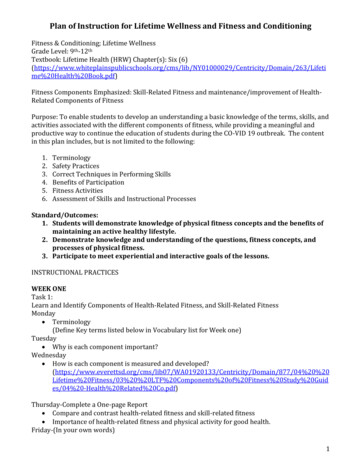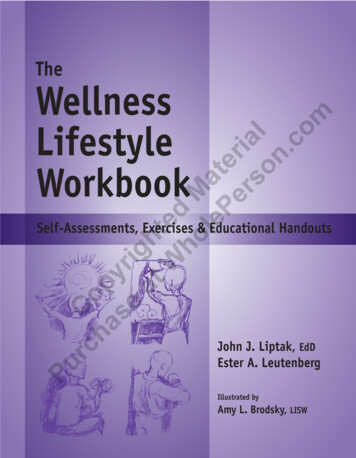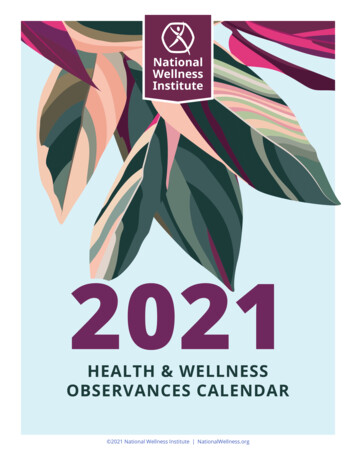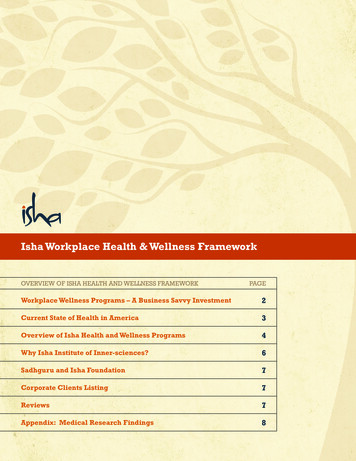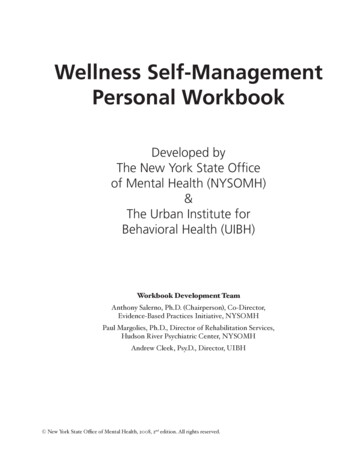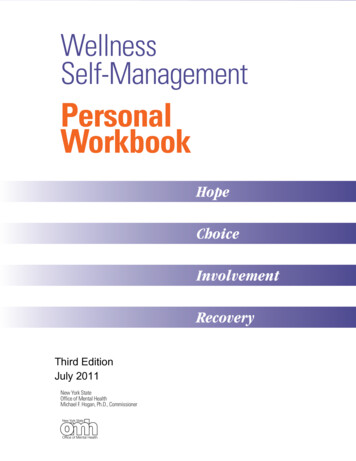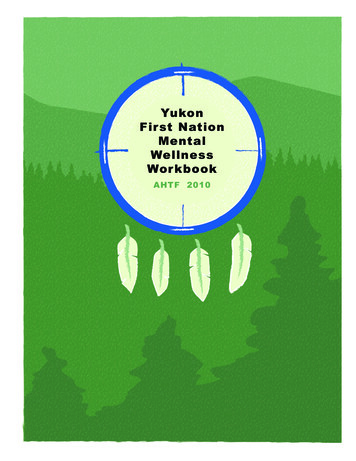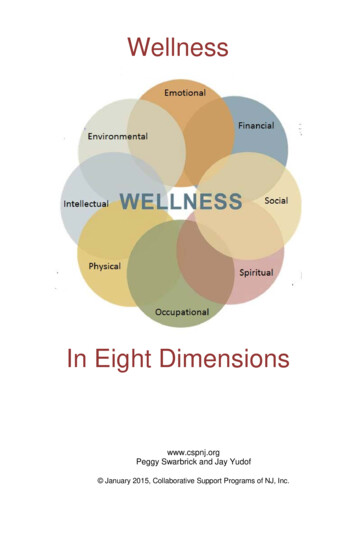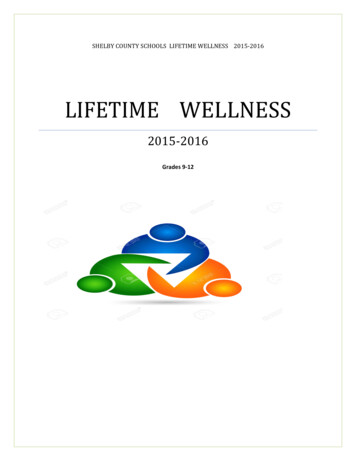
Transcription
SHELBYCOUNTYSCHOOLSLIFETIMEWELLNESS2015- ‐2016LIFETIMEWELLNESS2015- ‐2016Grades9- ‐12
2025.By2025,§ rcareerready§ 90%ofstudentswillgraduateontime§ llenrollinapost- tswithhigh- ‐quality,CollegeandCareerReadystandards- dresearch- k:Coursedescription- dgewhichoccursasaresultofphysicalactivity.
tivequizzes,fitnessgram,pacer,student- ntimewithinthequarters/semester.Tennessee- ections- houtthiscurriculummap,youwillseehigh- mbeddedinthemap,therearesomehigh- rteacheruse.
NationalStandardsforK- hysicalactivity,aphysicallyliterateindividual*: yofphysicalactivities. arioustypesofphysicalactivities. Participatesregularlyinphysicalactivity. Isphysicallyfit. h- ent,challenge,self- nandHealthJournal,75(3),27- ‐30.
Diamond Conceptual Framework: A K-12 Road Map forPhysical EducationThe diamond shape helps illustratethe progression of skills andconcepts taught in physicaleducation, which are guided bynational and state standardsand research on physical activityand physical education.Students should first learnthe fundamental skills needed to besuccessful in physical activities, justas they would need to learn to readbefore tackling Mark Twain. Nextthey should experience a variety ofactivities with the goal of finding afew they enjoy. We wouldn't wantthem to go through life thinking theonly way to stay healthy and fit isby running, playing basketball,and/or lifting weights. Lastly, wewant them to become proficient in afew chosen activities with the hopethat they will continue to participatein them throughout their lives.
on1. fhealth- ‐relatedactivities.2. th- xecutingexercises3. stayactiveinotherwaysthanteamsports 1. Movement2. MovementConceptsandPrinciples3. PhysicalActivity4. Fitness5. PersonalandSocialResponsibility 2014- :Students will improve their CardiovascularEndurance, Muscular Strength, MuscularEndurance and Flexibility/Mobility.Demonstrate the ability to apply advancedmotor skills and movement patterns relative toadvanced eye-hand/foot coordination and highlevels of strategy.Demonstrate proficient movement patterns in avariety of physical activities 9e.g., aquatics,dance and rhythms, individual and teamsports, fitness activities) strategies in a varietyof physical activities.Analyze biomechanical principles whileperforming physical activities.Participates in aerobic exercise at a mediumeffort, continuously for an extended period oftime.Demonstrates a proficient level ofcardiovascular fitness and identifies properlifting and stretching techniques.Demonstrates a variety of stretching exercises,specific to the physical activity.Demonstrates proper lifting techniques ofweights to increase muscular strength andmuscular formancesPeerObservationSelf- ‐AnalysisFitness- ‐GramTestingStudent- zzes
ShelbyCountySchoolsLifetimeWellness2014- orLifetimeWellnessStandard: uits,self- strength,MuscularenduranceandFlexibility1.3.1 movementpatternsrelativetoadvancedeye- .2 icalactivities.- yle2.6Fitness:Allstudentswillapplyhealth- ‐relatedandskill- vityEssentialLearning3.3.1 propriatetechnology3.3.2 educationclass3.3.3 veralifespan3.3.4 analyzethebenefitsofregularparticipationin
ysettings.2014- sonachievesandmaintainsahealth- ‐enhancinglevelofphysicalfitness. EssentialLearning lf- orself- ‐expressionandpersonalgrowth ousphysicalactivityidentifythecomponentsofhealth- lactivity
ness and ConditioningCore StandardHealth Related Fitness and ConditioningThe student will recognize and establish behavioralfactors leading to the development of total fitness.Students are required to participate in the followingactivitiesPre-Fitness TestingCompare fitness score.Set fitness goals for improvementPost Fitness TestingStudents will develop an individualized Fitness Planusing above information as a guideline (required)Students will describe trends in fitness (required)Log fitness activities outside of school (required)Essentiallearnings2014- ‐2015PerformanceIndicatorStudents will log fitness activities outside of schoolStudents will be able to identify and define conceptsof physical fitness.Students will be able to assess individual healthrelated components of fitness by evaluatingflexibility, cardiovascular endurance, muscularstrength, muscular endurance and body composition.Students will be able to set goals and design apersonal fitness plan.Students will be able to select cardiovascularendurance activities and practice skills needed forsuccessful participation in lifetime sports.Students will participate in plyometric,agility and rhythmic activities (dance and stepaerobics etc.).Students will participate in both aerobic andanaerobic activities.Students will apply proper safety practices as relatedto activity.Students will be able to distinguish between fact andfallacies to fitness products, services and marketing,Students will practice relaxation techniques.Use activities listed below to help studentsimprove or maintain HFZ standardsthroughout the school year Circuit Training,Aerobics,Cardio-kick boxing,Yoga,Weight Training,Dynabands,Jump Rope,Fitness Stations,Walking/Jogging, Cross Training,Obstacle courses,Cycling,In-line skating,Physical Best Activities,Fitness Lab
ShelbyCountySchoolsLifetimeWellness2014- ‐2015IndividualandDualSportsCoreStandardThe student will exhibit a level of competency,advancing to a level of proficiency, in a specificindividual or dual sportParticipate in individual and dual sports to include butnot limited to bowling, badminton, golf, pickleball, tabletennis, shuffle board, skating (In-line, roller) and trackand field.Apply movement concepts and principles to the learningand development of sport skillsPerformance IndicatorDemonstrate basic motor skillsAcknowledge good play from an opponent duringcompetitionSelect and participate in a sport that providesenjoyment and challenge.List risks and safety factors.Examine success and performance limitations of selfand others.Execute strategies, protocols and rules in gamesituationsApply safety rules.Exhibit positive personal and social skills needed toworkwith others and independently.Discuss how participating in individual and dual sportscan be enjoyable, self challenging and onfidentlyinindividualanddualsports.Performance IndicatorTeam SportsThe student will exhibit competency in advancing toproficiency in a team sport.Use skills consistently and in the appropriatesettings.Reinforce team sports as lifetime activities.Students will participate in team activities to include butnot limited to baseball, basketball, softball, soccer andvolleyball.Students will describe principles of training andApply safety practices.Improve cardio respiratory efficiency andneuromuscular sandstrategies:
ShelbyCountySchoolsLifetimeWellness2014- ‐2015conditioning appropriate to team sports Connect the importance of skill development tosuccessful game play.Demonstrate knowledge of rules and strategies. Develop anappreciation for teamwork and fair play. Apply safety rules. Exhibit positive personal and social skills needed to workwith others and independently. Discuss how participating in individual and dual sports can beenjoyable, self challenging and contribute lifestyle Develop the ability to participate confidently inindividual and dual sports. nd2 Nine WeeksRhythmic ActivitiesCore StandardThe students will exhibit a level of competency byperforming various rhythmic activitiesThe student will perform numerous rhythmic activities to includebut not limited to line dance, ethnic dance and creative dance. Demonstrate the correct technique fora team sport movement patternShow progress in a drill thatrequires a combination ofmovement skillsDemonstrate knowledge of rules,strategies& safety proceduresCreates a team game withoffensive and defensivestrategiesDevelop a practice plan for improving askillShow evidence of skill transferLog movement activities playedoutside of schoolAnalyze body types/compareefficiency at different skillsAnalyze movement performanceusing principles of resistanceDemonstrate conflict resolution skillsDemonstrate positive interactionduring cooperative gamesPerformanceIndicatorStudents will:Perform simple movement patterns to the beat.Successfully demonstrate even and unevenlocomotor movements.Demonstrate the ability to keep time to the beat.The student will recognize how elements of movement (space,time, force, relationship) and creativity apply to rhythmicmovement.Students will consider the importance of the culturalbackground to various dances.Students will display appropriate etiquette toward others whenperforming rhythmic activities.Follow word cues (step, turn,close, etc.) Demonstrate basicdance steps.Transfer steps learned from one dance toanother Create a dance using simplesteps.Performance Indicator
ShelbyCountySchoolsLifetimeWellness2014- ‐2015Emphasize safety concepts while participating.Educational GymnasticsCore Standard.The student will practice body control through variouseducational gymnastic activities appropriate to theindividual confidence level in a non-competitive setting.Perform basic body movements that require musclecontrol to include rolls, balance and landing skillsand combining skills that are continuous.Practice activities that emphasize arm strength,abdominal strength and flexibility.Relate responsible safety behavior.Students will perform individual skills to include but notlimited to balance, transferring of weight and jumpingand landing.Students will consistently practice responsible safetybehavior.Students will participate in activities that develop armstrength, abdominal strength and flexibilityRefine and perform a minimum of five individualskillsRefine and perform a predetermined sequentialgymnastics routine to his skill level.Students will become familiar with group routines.Essential LearningsBasicHumanNeeds,GoodMentalHealthCore StandardStudents will demonstrate the ability to use mentalhealth and emotional health knowledge, skills andstrategies to enhance one’ self-concept and one’srelationship with others.Performance IndicatorRecognize and apply effective communication skillsDefine characteristics of good mental healthApply the decision making process to personal issuesand problems.Demonstrate, evaluate and analyze strategies to managestress.Recognize and respond to potential destructivebehaviorsEssential LearningsI.MENTAL HEALTHA. Basic Human Needs1. Hierarchy of needs2. Relationship between human needs andindividual behaviorsB. Good Mental Health1. Characteristics2. Impact of emotional needs on mentalhealth3. EmotionsExplain Maslow’s hierarchy of needs.Identify strategies to relieve stress.Demonstrate conflict resolution skillsDiscuss the effects violence has on mental health.Identify the symptoms of depression and warningsigns of suicide
ShelbyCountySchoolsLifetimeWellness4. Factors that shape personality5. Self-concept and self-esteem6. SexualityC. Stress1. Common stressors and their impact2. Stress response and physiologicalchanges3. Stress management coping techniquesD. Conflict Resolution1. Appropriate coping and resistance skills2. Socially acceptable ways of resolvingConflict2014- ‐2015E. Violence1. Causes2. Forms3. EffectsF. Depression, Suicide, and Grief1. Signs, symptoms, and treatment for depression2. Signs of a potential suicide3. Stages and sequence of the grief processUnitAlcohol, Tobacco and Other DrugsCore StandardStudents will demonstrate the ability to use drugknowledge, decision-making skills, health enhancingstrategies , non-use and abuse of medications, alcohol,tobacco and other drugs.Students will identify factors that influence the use oftobacco, alcohol and other drugs.Investigate effects of prescription and OTC drugs andresulting consequences.Identify and examine physical, psychological, social andlegal consequence of the use of tobacco, alcohol andother drugs.Access information and services for of addictivebehaviors.Essential LearningSUBSTANCE USE & ABUSEA. Harmful Effects of Drugs1. Over-the-counter vs. prescription drugsStudents will:Analyze the intended impact of advertising on thesale and purchase of tobacco and other drugsDemonstrate strategies for refusing tobacco, alcoholand other drugs.Analyze genetics as a predisposing risk factor ofalcohol, tobacco and other drug use.Analyze physical effects of combining OTCmedicines with alcohol and other drugs.Create a lifelong plan for appropriate use ofprescription and OTC medication.Define the stages of alcoholism.Identify dangers of secondhand smokeDiscuss pressure tactics use in advertising to enticedrug use.Explain co-dependency and enabling behaviors.
ShelbyCountySchools2.3.4.5.6.7.8.9.10.Categories of drugs and examplesDrug use & drug abuseConsequencesDrug combinationEffects of alcohol on fetusEffects on job and sports performanceHarmful effects of tobacco productsPassive smokingEffects of drug use on crime, disease,pregnancy, and personal relationships11. Behavior changes12. Stages of alcoholism and its effects13. Body functions14. Short and long term physical effects15. Reasons for smoking and/or drinking16. Legal issues17. Blood alcohol level18. Drug testingB. Pressures to Use Drugs1. Advertising2. Refusal skills3. Commitment to a drug free lifestyleC. Resources1. Co-dependency and enabling behaviors2. ProgramsLifetimeWellness2014- ‐2015
ShelbyCountySchoolsLifetimeWellness2014- ‐2015Third Nine WeeksPersonal and Consumer HealthPerformance IndicatorThe student will:CoreStandardStudents will demonstrate the ability to use knowledge,skills and strategies to develop sound personal andconsumer health practices involving the use of healthcare products, services and community resources.The student will demonstrate the ability to identify andpractice health enhancing behaviors and reduce healthrisks to live safer, healthier lives.The student will describe and analyze risk factors andbehaviors that contribute to the development of illnessEssential LearningsDISEASE PREVENTION & CONTROLA. Infectious Diseases1. Common infectious diseases2. Environmental lifestyle factors3. Pathogens and their affects4. Seeking medical care5. Community agenciesB. Lifestyle Diseases1. Common lifestyle diseases2. Heredity, environmental, and lifestylefactors3. Risk factors and warning signs4. Prevention, causes, warning signs, andtreatment5. Modifying risk factorsFamily Life and Human SexualityCore StandardStudents will demonstrate the ability to use humandevelopment knowledge, social skills and healthenhancing strategies to promote positive relationshipsand healthy growth and development throughout the lifecycle.Students will explain the process of human reproduction(fetal and maternal).Evaluate how factors such as culture, media and peersinfluence health information, perceptions, behaviorsand product and service selection.Demonstrate the ability to assess school andcommunity health services for self and others.Analyze situations requiring professional healthservices.Evaluate the impact of technology, research andmedical advances on personal, family and communityhealth.Identify the role played by each of the following incausing illness.1. Family history2. Lifestyle choices3. Environment4. GeneticsAnalyze influences that affect the cause of illnessDetermine a plan of action to reduce health risksand/or improve personal health.1. Regular medical check-up (dental)2. Immunizations and screening (vision andhearing)3. Diet and weight management4. Exercise and rest5. Environmental exposure (loud music)Performance Indicator Describe fertilization, fetal development andthe birth process. Identify the most prevalent congenital andhereditary conditions that effect the fetus. Investigate factors that may contribute to ahealthy relationship. Examine potential causes of relationship
ShelbyCountySchoolsLifetimeWellnessDistinguish between healthy and unhealthy relationshipsAnalyze factors that influence an individual’s decisionsconcerning sexual behavior.Demonstrate capacity for setting sexual limits(abstinence)Essential Learningsfailures SEXUALITY & FAMILY LIFEA. Healthy and Responsible Relationship1.2.Students will apply strategies to select peers to befriends or potential romantic partners and ways tobuild relationshipsStudents will describe ways to communicatecaring love and respect in a variety ofrelationshipsB. Relationships and Responsibility1.2.3.4.5.Students will describe ways to develop trueintimacy without having sexual intercourse.Explore how stereotypes and peerInfluence can impact sexual decision making.Describe different ways of communicating caring,love, and respect without sexual intercourse.Clarify the benefits of abstaining from sex orceasing sex if sexually activeStudents will analyze influences that encourage ordiscourage risky behaviors Positive and negative peer pressures andmanipulation Effects of television, movies, and the media Social, emotional, intellectual, and economicaspects of dating Abstinence as a positive choice forAdolescentsC. Building Healthy Relationships1.2.3.4.Describe ways to develop healthy relationships withfriends and family members and healthy datingrelationships.Talk with parents and/or other trusted adults aboutrelationships and sexual issues.Describe the contributions healthy relationshipsmake to the quality of lifeCompare and contrast different ways ofcommunicating caring and love in differentrelationshipsDiscuss why teens sometimes confuse love, sex andintimacyExplore the effects of personal and familystress on relationships.Investigate factors that contribute to sexualidentity.Examine how culture, value systems and thefamily influence attitudes toward sexualbehavior. Analyze risks and consequences of sexualactivity. Analyze how perceptions of the risk andconsequences of sexual activity impactdecisions. Explain how laws relate to relationships andsexual behavior.Examine resources to maintain or promotereproductive health.Demonstrate how to use decision-makingsteps for setting sexual limits.Explain influences on sexual limit.Demonstrate advocacy for respecting sexuallimits.Demonstrate ways to communicate aboutsexual behavior and abstinenceDemonstrate refusal strategies for sexualpressuresAdvocate abstinence from sexual intercourseas the most effective and healthy means forpreventing pregnancy and sexuallytransmitted infections.Describe different ways of communicatingcaring, love and respect without sexualintercourseExplain the influence of gender differences onsexuality.Explore ho a healthy responsible relationshipas a couple means avoiding possible physical,emotional, economic and legal consequencesof sex, including pregnancy, HIV and otherSTIs.Identify abstinence from sexual activity as thehealthiest choice. D. The Many Facets of Intimacy1.2014- ‐2015 Students will discuss how to support thosewho make good decisions about implementing
ss characteristics of intimate relationships,both friendships and romantic relationshipsIdentify honesty and safety as key ingredients in ahealthy relationshipAnalyze the impact of sexual intercourse onbuilding intimacy in relationships and the benefitsfrom abstaining from sex.Describe ways to develop intimacy in four domainsIdentify and select things to do to build trueintimacy without having sexual intercourseE. Let’s Hear The Facts about sexually transmittedinfections, including HIV and AIDS.Students will list the most prevalent sexuallytransmitted infections2. Students will summarize the symptoms, modesof transmission, consequences and how toprevent transmission of six sexually transmittedinfections: HVI, Chlamydia, gonorrhea, genitalwarts, herpes, and syphilis.3. Students will identify sexually transmittedinfections as a possibility of sex that can bepr3evented by abstinence.1.F. The Stakes Are HighStudents will recognize teen vulnerability toHIV infection2. Students will analyze the physical, social andemotional impact of having a sexuallytransmitted infection.3. Students will analyze sexual behaviors todetermine risk of transmitting HIV and othersexually transmitted infections1.sexual limitations. 1. H. Sexual Harassment, Promiscuity, and Date Rape G. Know the RisksCategorize the different behaviors according tolevel of risk for transmission of HIV and otherSTIs2. Establish personal limits for personal behavior2014- ‐2015Discuss the difference between infatuationand love.Discuss the difference between sexual activityand sexual intercourse.Discuss how sex and love is different.Demonstrate appropriate refusal skills.Define and describe intimacy using the phrase“in to me see”Discuss the type of intimacy that are inpositive friendships.Form triads and individually analyze
Shelby!County!Schools! Lifetime!Wellness! 2014B2015!! ’ ’ ’ 1st’Nine’Weeks! ’ Fitness and Conditioning Core StudentsStandard of Health Related Fitness and Conditioning The student will recognize and establish behavioral factors leading to the development of total fitness.
